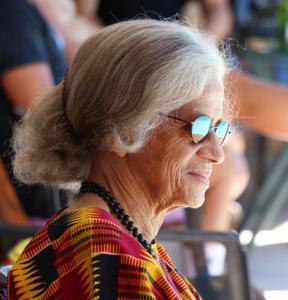
Archive category
Publication date
Published date
Download the file
In the late 1950s Ottilie Schimming Abrahams was among the first generation of Namibian students who pursued post-secondary education in Cape Town. Ottilie Schimming Abrahams was among the leading members of this tiny Namibian intelligentsia that formed various political cum educational organisations in the 1950s, such as the South West Africa Student Body (SWASB) and South West Africa People’s Association (SWAPA). This incipient intelligentsia, and ‘Tillie’ among them joined the contract workers who formed the Ovamboland People’s Congress (OPC) in Cape Town in 1957; their best-known member Andimba Herman Toivo ya Toivo who was by then working with the railways in Cape Town. This group was formed by Namibians, mostly men, who had been able to get out after World War 2 of what had previously been a tightly sealed, fairly isolated colony. They were influenced by various strands of South African resistance politics, and interacted in Cape Town with members of the ANC, the Liberal Party, and also communists such as Jack Simons and Ray Alexander. It was a group whose political activist stance and cosmopolitanism was much suited to the young woman, Ottilie, who had been born in Windhoek’s Old Location into a family, in which the children spoke Otjiherero to one grandmother, and Damara to the other, among themselves often conversed in Afrikaans and later in English, while their parents sometimes spoke German to each other.
It is well-known and has been discussed on this site before that the young Ottilie Schimming Abrahams and her husband Kenneth Abrahams, a Capetonian UCT medical school graduate, were part of the YU CHI CHAN club, which has been described as a Maoist underground organisation. As a young woman Ottilie was among the otherwise male group of Namibian activists in Cape Town, and then in the early 1960s one of only a handful of Namibian women in exile, probably not more than five women were in exile at the time, as Libertina Apollus (married name Amathila) later remembered. [1] Ottilie Abrahams and her husband Kenneth Abrahams arrived in Dar es Salaam in August 1963. She was the Secretary for education and served on the SWAPO Executive Committee until the Abrahamses were suspended from SWAPO a few months later for raising questions about how funds were being spent. [2]
Ottilie, Kenneth and others returned to Namibia after having been granted political amnesty at the beginning of the South African administration attempts at an ‘internal settlement’ for the ‘South West Africa’ territory. They came from exile in Sweden in 1978 and joined the campaign for internal elections for a Constituent Assembly, which was a rather controversial move at the time when SWAPO called for a boycott of the internal elections. Voter turnout stood rather high at eighty percent, which was due to both intimidation but also some genuine popular support. [3]
In this climate, while being part of forming a new political party, Namibia Independence Party (NIP), later part of the Namibia National Front (NNF), which still gained one seat at the 1989 independence elections, Ottilie Abrahams was instrumental in starting the Namibian Women’s Association (NAWA) in 1979 together with a number of Windhoek-based black professional women. NAWA was started by women who were affiliated to the NNF but, they insisted, the women’s organization remained an autonomous women’s organization. Recalling this time, in 1991 Ottilie Abrahams spoke about the virulent, even violent opposition of male NNF politicians, “who did not want a women’s organization which will demand equal rights for all. .. when I used to pick up women for meetings, my car was stolen by the husbands. And many women who came back from meetings were beaten up.” (Interview, May 1991) [4] The group around Ottilie Abrahams hence decided to let NAWA fall dormant and instead concentrate on community development, and [5]especially educational projects, including in 1985 the foundation of Jacob Marengo Tutorial College, whose principal Ottilie remained until her death. Only when the 1989 independence process promised genuine change did they start to organize NAWA as a women’s organization again, mostly in southern and central Namibia where Ottilie was well-known as a community development organiser.
 (left to right) Marcus Solomons, Ottilie Abrahams and Polly Slingers (ex-Trafalgar High) Picture credit: Raymond van Diemel
(left to right) Marcus Solomons, Ottilie Abrahams and Polly Slingers (ex-Trafalgar High) Picture credit: Raymond van Diemel
In 1990 Ottilie Abrahams was a significant player in the ultimately failed attempts of establishing an encompassing women’s umbrella body to coordinate the activities of the different women’s organisations, then active in newly independent Namibia. When the year-long deliberations about “women’s unity” did not result in an agreement – ultimately due to political and personal misunderstandings – two bodies were formed in 1991, one association called NANAWO (Namibia National Women’s Organisation), which was close to the SWAPO government, and the Federation of Namibian Women. Ottilie Abrahams brought much vibrancy to the effort of establishing the Federation, although this initiative too fell victim to party political quarrels. After this NAWA returned to a focus on community development efforts, including the Girl Child initiative and providing support for women, including legal advice as Ottilie described in the SISTER Namibia interview.
Ottilie Abrahams was a most energetic, brilliant force in the today largely forgotten initiatives of organizing women for a powerful women’s movement for social and political change at the time of Namibian independence. This was another tremendous aspect of this extraordinary woman’s life.
Endnotes
[1] Heike Becker, Namibian Women’s Movement 1980 to 1992: From Anti-colonial Resistance to Reconstruction (Frankfurt: IKO, 1995), 146. ↵
[2] Martha Akawa, The Gender Politics of the Namibian Liberation Struggle (Basel: Basler Afrika Bibliographien, 2014), 76. ↵
[3] Marion Wallace (with John Kinnahan), A History of Namibia. From the Beginning to 1990 (London: Hurst), 292. ↵
[4] Becker, Women’s Movement, 321. ↵
[5] Becker, Women’s Movement, 358-68. ↵
Main Picture credit: Alan Petersen